Although I’m not photographing the Olympics that doesn’t mean these things entirely pass me by. It would be impossible not to notice them, especially when I went to Stratford to take a tour of the Carpenters Estate with the residents association, CARP, Carpenters Against Regeneration Plan.
This is an estate right next door to the Olympic site, and parts of it are still owned by the Worshipful Company of Carpenters who first developed it in the Victorian era with a mixture of industrial sites and workers housing, though the area was reworked in the 1940s by the Luftwaffe and in the 1960s by Newham Council. It’s actually one of the better developments of that area, showing that the architects and planners had learnt at least a little from their earlier mistakes, and the 3 tower blocks in among the low rise terraces and maisonettes were rather better built than Ronan Point which was a mile or so south-east.
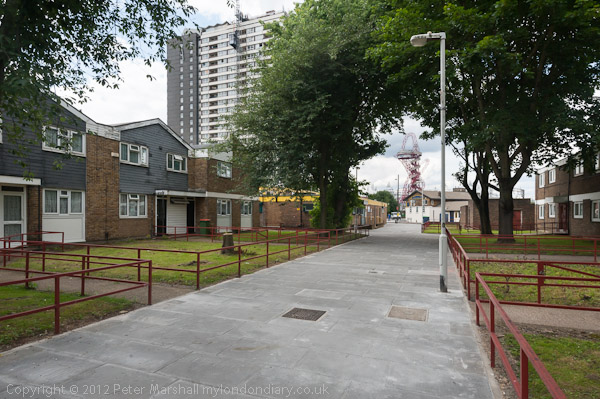
Carpenters Estate with the Orbit – rather lower than the tower blocks
But it’s an estate that doesn’t fit with Newham’s plans for Stratford to become London’s third city, and a bit of a drain on their resources which could do a lot for the council’s finances if sold off. Already a prime site close to excellent transport connections and with some sites on its edges along the High St and riverbank already becoming largely unaffordable private developments, the development of the Olympic Park on its third side makes it even more desirable.
Newham started moving out tenants in 2006, and many perfectly decent and desirable council-owned properties have now been empty there for six years in an area with probably the worst housing problems in the country – they made the national news a few months back for trying to get some of their tenants rehoused in areas across the country – including Stoke-on-Trent.
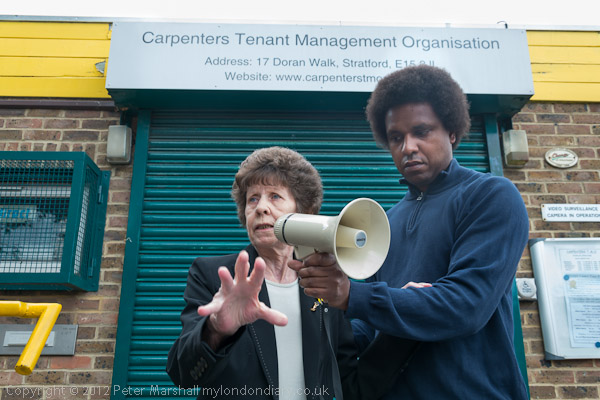
A Carpenters Estate resident talks about her determination to stay in her home
But most people didn’t want to move from Carpenters, as it was a relatively quiet and popular place with a strong settled community, including many who had lived there since it was built and in a very convenient location. Tenants are easily bullied by the council, but owner occupiers or leaseholders can put up more of a fight. Like many estates it had an official residents organisation, a TMO (Tenant Management Organisation) which also included owner occupiers and leaseholders, which wasn’t sympathetic to the plans to get rid of the estate, so the council apparently organised a takeover, denying owner occupiers and leaseholders standing for office and losing the nomination papers of five candidates so that the right people got elected.
Which led to residents of the estate setting up CARP, which has tried to publicise what is happening to the estate and keep on living there. One of the things they have done is to organise tours of the area to show people what is happening, and I was invited to go one one of these a couple of weeks ago.
Although part of the impetus for redevelopment of the estate has come from the Olympics, this was not an anti-Olympic protest. CARP isn’t against the Olympics, just for keeping their homes. One of the highlights of the several previous tours that they have run – all without any problems – has been a visit to the flats of two residents on one of the three tower blocks, Lund Point.
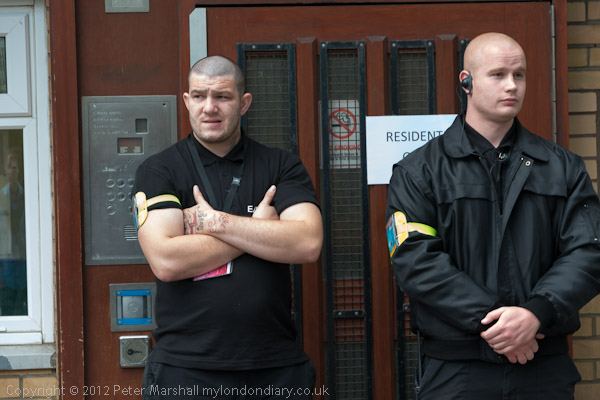
BBC employed security men block our entrance to Lund Point
This time, things were different. Our entrance to the flats was blocked by two burly security men working for the BBC who refused us entry. The BBC have their studios in the top 5 floors of the tower and wanted to keep everyone out of the block. We argued briefly and told them we would return in half an hour after we had seen the rest of the estate to go in.
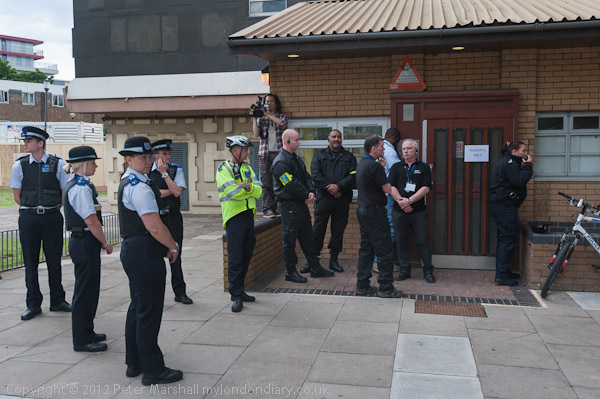
PCSOs and a police officer join the BBC in refusing us access
When we got back, as well as the BBC men (and there were a few more of them around) there were also half a dozen PCSOs (Police Community Support Officers) and a police officer. She told us that we could not enter, and she was phoning a colleague to find out more. We argued that they had no right to stop us as we were with a resident who had invited us to visit his home, but the police and PCSOs stopped even him and his family from entering.
A further officer arrived a few minutes later and insisted he talk only with one of the residents, and we had the same argument with him. A couple more police vans arrived, and the police held a small conference on the pavement outside. After another 10 minutes or so it was clear that the police had realised that the BBC attitude was unreasonable and that residents of the flats had to be allowed to entertain guests, and with police and security escorting us we were allowed up to the flat on the 4th floor.
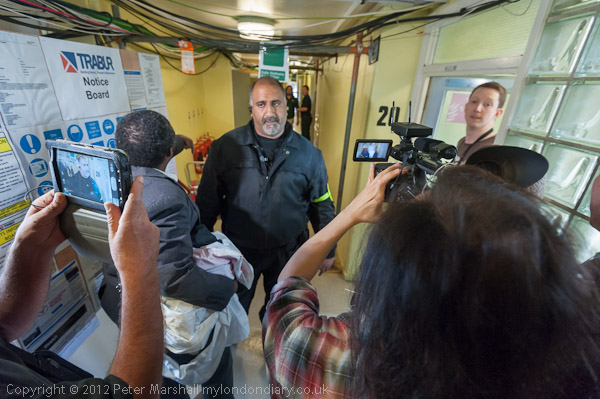
Journalists film as the BBC security block our route to visit a resident on the 20th floor
But we also had an invitation to visit another resident on the 20th floor, and with a view over the Olympic site. This is one of the floors that the BBC is actually working in, despite at least one flat on it being owned and still occupied by residents. Again the BBC security told us we couldn’t go there.
We got in the lift, pressed 20. When the doors opened there were BBC security stopping us getting out. It was pretty uncomfortable, with too many people crammed in a lift, most holding big video cameras up above their heads to squeeze in. Someone said “Anyone with medical conditions?” and I shouted “Diabetes!”. The BBC security relented a little, moved back a couple of feet so I had enough space to get my own camera up in the air, then squeezed round one of the other guys low down to get a better view.
Someone phoned the guy we had an invite from and he came to meet us and then the security realised they had to let us through. So we got to walk along a cable-strewn corridor to his flat to talk to him about the disruption of having the BBC working all around his flat, and to see the view of the Olympic site from his balcony, where our tour leader talked about the Olympic site and the problems it caused for the estate.
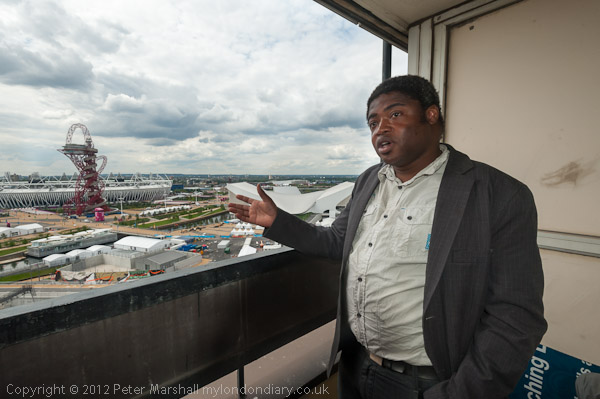
The 3 Carpenters Estate point blocks have a better viewpoint than the Orbit
Police and BBC security followed us too on our way out, and I was pleased to leave the building and cross the road to the Carpenters Arms. I needed a drink. More pictures and information about what has been happening there in Newham’s Shame – Carpenters Estate and more on the illegal actions of the BBC security and police in Police Deny Olympic Residents Access. And you can also see more of that view from Lund Point in Olympic Views.
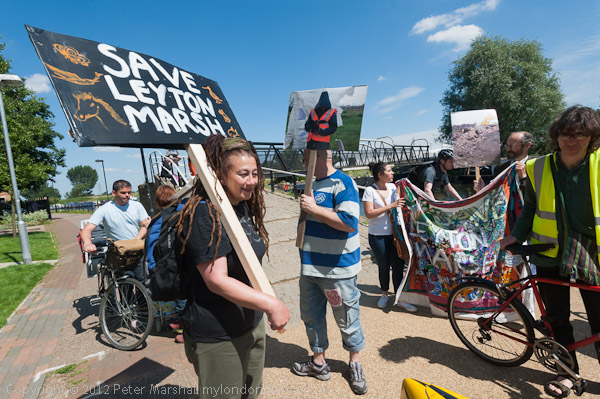
Marching along the towpath from Leyton Marsh to the closure at Eastway
The following day I covered a protest against the closure of the canal tow-path, the only safe route remaining for cyclists between Hackney Wick and Stratford. It wasn’t a big protest, but the closure effects many people cycling to work, as well as those cycling for leisure – and group after group of these came along and stopped at the security fence across the path while the protest was taking place. More about it in Cyclists Protest Olympic Towpath Closure.
The Olympic lanes and diversions clearly put cyclists (and pedestrians) at greater risk, and clearly their safety has nowhere been allowed to stand in the way of making Olympic traffic run smoothly. But the tow-path ban is just unreasonable. There is a 10 ft high electrified fence with frequent security cameras all along the side of it, and cyclists and pedestrians pose no real security risk to the Olympics.
The death of cyclist Daniel Harris, dragged under an Olympic double-decker bus while cycling along the northern edge of the Olympic site would appear to have been contributed to by poor temporary road marking and poor planning of the junction for the Olympic traffic, although perhaps more on this will emerge at the inquest. Possibly too, like many cyclists he was only on that particular road because of the closure of the cycle-safe Greenway which passes through the centre of the Olympic site and was shut to through traffic in May.
The protest was a family-friendly affair with a barbecue and has become a weekly event, incorporating a cycle ride, accompanied by a number of police cyclists, which probably makes this the only really safe time to ride around the area. Last Sunday the rode as closely as possible around the edge of the Olympic site and left flowers at the roadside memorial to Daniel Harris.
The attitude of the police to this protest contrasts strongly with their attitude to Critical Mass on the evening of the opening ceremony, when 182 of those taking part – more than a third – were kettled and then arrested in what was a new Olympic record for arrests, under a rather doubtful use of section 12 of the Public Order Act 1986. Given the long and largely peaceful record of Critical Mass in promoting cycling in London (and the House of Lords ruling in 2008 that their rides were not unlawful) it seemed both unnecessary and in completely at odds with the Olympic legacy claims to be promoting sport – including cycling – for all.
________________________________________________________
My London Diary : Buildings of London : River Lea/Lee Valley : London’s Industrial Heritage
All photographs on this and my other sites, unless otherwise stated are by Peter Marshall and are available for reproduction or can be bought as prints.
To order prints or reproduce images
________________________________________________________
London Cycling Campaign now have a good article:
http://lcc.org.uk/articles/wiggins-call-for-helmet-compulsion-is-damaging-diversion-from-lack-of-safe-olympic-cycle-routes
which has a photograph of the junction along with their view on the ‘accident’ as well as Mr Wiggins’ unfortunate comments. I’ll quote just one short paragraph which sums up their view of the Olympic cycle provision:
“This crash confirms our worst fears about the failure of Olympic Authorites and Transport for London to provide adequate safe cycle routes around the Olympic Park: a huge amount of money has been spent with very little to show for it.”
There is now (Nov 2012) a petition “UCL Council: Stop The Displacement of Carpenters Estate Residents” on Change.org which I’ve signed and you might like to consider signing:
http://www.change.org/en-GB/petitions/ucl-council-stop-the-displacement-of-carpenters-estate-residents